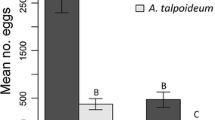Summary
Cophixalus parkeri is a terrestrial breeding microhylid frog from the montane moss forests of northeastern New Guinea. The pattern of parental care in this species and its adaptive significance was studied in the field and in the laboratory. Egg brooding, is performed by the male in most cases, and much less frequently by the female. The parent remains with the clutch throughout the 85–100 day prehatching period. Egg removal experiments demonstrated that survivorship of embryos significantly decreased in the absence of the attending parent. Mortality of unattended embryos may be caused by a variety of factors, including fungal infection, egg cannibalism, predation by arthropods, and abnormal development.
Brooding adults can provide protection to their developing offspring via several possible mechanisms eg. aggressive defense of territories on which eggs are deposited, ingestion of potential arthropod predators, and egg turning (Fig. 2).
Several differences were found in the quality and quantity of food ingested by brooding versus non-brooding adults collected in the same locality during the same period. On average, brooding adults consumed less food and of lower quality than non-brooding adults (Table 1). These differences in diet were correlated with length of time parents had attended their eggs before they were examined (Fig. 3). The reduced food intake during egg brooding is reflected by significantly smaller fat bodies and less carcass fat in egg brooders relative to nonbrooding adults (Table 1). These results are discussed in terms of relative costs and benefits of parental care in this species.
Similar content being viewed by others
References
Fitzpatrick LC (1976) Life history patterns and utilization of lipids for energy in amphibians. Am Zool 16:725–732
Forester LC (1979) The adaptiveness of parental care in Desmognathus ochrophaeus (Urodele: Plethodontidae). Copeia 1979:332–341
Forester LC (1981) Parental care in the salamander Desmognathus ochrophaeus: Female activity pattern and trophic behavior. J Herpetol 15:29–34
Gittleman JL (1981) The phylogeny of parental care in fishes. Anim Behav 29:936–941
Golley FB (1961) Energy values of ecological materials. Ecology 42:581–584
Golley FB (1969) Caloric value of wet tropical forest vegetation. Ecology 50:517–519
Gressitt JL, Nadkarni N (1978) Guide to Mt. Kaindi: Background to montane New Guinea ecology. Wau Ecology Institute Handbook, no 5
Kaplan RH, Crump ML (1978) The non-cost of brooding in Ambystoma opacum. Copeia 1978:99–103
Kluge AG (1981) The life history, social organization, and parental behavior of Hyla rosenbergi, Boulenger, a nest building gladiator frog. Misc Publ Zool Univ Mich 160:1–170
Kryzsik AJ (1980) Trophic aspects of brooding behavior in Desmognathus fuscus. J Herpetol 14:426–428
Lamotte AJL, Lescure J (1977) Tendances adaptives a l'affranchissment du milieu aquatique chez amphibiens anoures. Terre Vie 31:225–312
LeBoeuf BJ, Whiting RJ, Gantt RF (1972) Perinatal behavior of northern elephant seal females and their young. Behaviour 43:121–156
Maiorana VC (1976) Size and environmental predictability for salamanders. Evolution 30:599–613
Maynard Smith J (1977) Parental investment: a prospective analysis. Anim Behav 25:1–19
McDiarmid RW (1978) Evolution of parental care in frogs. In: Burghardt GM, Bekoff M (eds) The development of behavior: comparative and evolutionary aspects. Garland, New York, pp 127–147
Mudrack W (1969) Pflege und Zucht des Blattsteigerfrosches der Gattung Phyllobates aus Ecuador. Salamandra 5:81–84
Ridley M (1978) Paternal care. Anim Behav 26:904–932
Robbins CT (1983) Wildlife feeding and nutrition. Academic Press, New York
Rowher S (1978) Parent cannibalism of offspring and egg raiding as a courtship strategy. Am Nat 112:429–440
Salthe SN, Mecham JS (1974) Reproductive and courtship patterns. In: Lofts B (ed) Physiology of the Amphibia. Academic Press, New York, pp 309–521
Silverstone PA (1976) A revision of the poison-arrow frogs of the genus Phyllobates Bibron from Sagra (Family Dendrobatidae). Nat Hist Mus Los Angeles Co Sci Bull 27:1–53
Simon MP (in press) The influence of conspecifics on amphibian egg and larval mortality. In: Hausfater G, Hrdy SG (eds) Infanticide: comparative and evolutionary perspectives. Aldine Press, New York
Taigen T, Pough H, Stewart M (in press) Water balance of terrestrial anuran (Eleutherodactylus coqui) eggs: importance of parental care. Ecology
Tilley SG (1972) Aspects of parental care and embryonic development in Desmognathus ochrophaeus. Copeia 1972:532–540
Townsend D (in press) The adaptive significance of egg brooding in Eleutherodactylus coqui. Anim Behav
Trivers RL (1972) Parental investment and sexual selection. In: Campbell B (ed) Sexual selection and the descent of man. Aldine Press, Chicago, pp 136–179
Tyler MJ (1963) A taxonomic study of amphibians and reptiles of the Central Highlands of New Guinea with notes on their ecology and biology, vol 1. Anura, Microhylidae. Trans Soc South Aust 36:11–34
Tyler MJ (1976) Frogs. Collins, Sydney
Vaz-Ferreira R, Gehrau A (1975) I. Attencion de la cria y actividades alimentarias y agresiva relacionades. Physis Secc B Aguas Cont Sus Org 34:1–114
Villa JD (1977) A symbiotic relationship between frog (Amphibia, Anura, Centrolenidae) and fly larvae (Drosophilidae). J Herpetol 11:317–322
Villa JD (1979) Two fungi lethal to frog eggs in South America. Copeia 1979:650–655
Wells KD (1981) Parental behavior of male and female frogs. In: Alexander RD, Tinkle DW (eds) Natural selection and social behavior: recent research and new theory. Chiron Press, New York, pp 185–197
Woodruff DS (1977) Male postmating behavior in three Australian Pseudophyrne (Anura: Leptodactylidae). Herpetologica 33:296–303
Wooton RJ (1979) Energy costs of egg production and environmental determinants of fecundity in teleost fishes. Symp Zool Soc (Lond) 44:133–159
Zweifel RG (1956) Results of the Archbold Expedition No. 72. Microhylid frogs from New Guinea with descriptions of new species. Am Mus Novit 1766:1–49
Zweifel RG, Tyler MJ (1982) Amphibia of New Guinea. In: Gressitt JL (ed) Biogeography and ecology of New Guinea, Monogr biologicae, vol 42. Junk, The Hague, pp 759–801
Author information
Authors and Affiliations
Rights and permissions
About this article
Cite this article
Simon, M.P. The ecology of parental care in a terrestrial breeding frog from New Guinea. Behav Ecol Sociobiol 14, 61–67 (1983). https://doi.org/10.1007/BF00366657
Received:
Accepted:
Issue Date:
DOI: https://doi.org/10.1007/BF00366657




